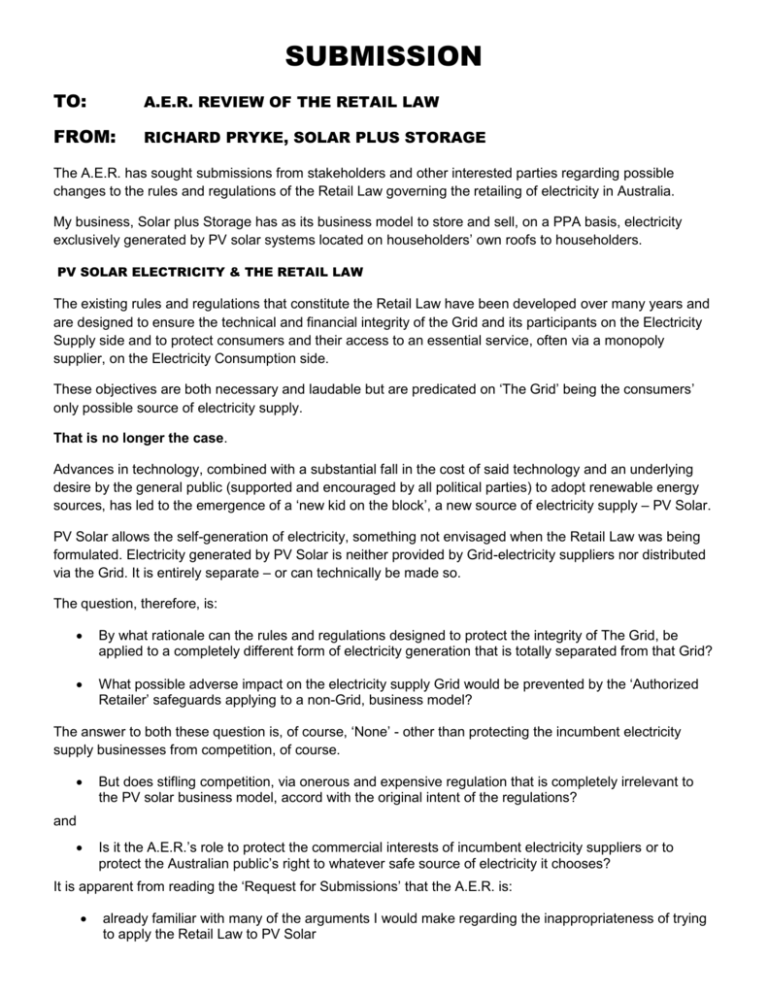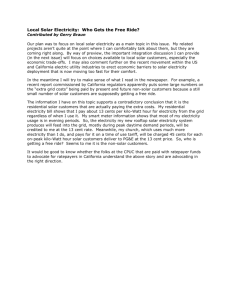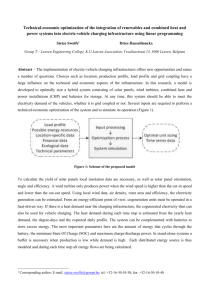Solar Plus Storage - Submission to AER Issues paper
advertisement

SUBMISSION TO: A.E.R. REVIEW OF THE RETAIL LAW FROM: RICHARD PRYKE, SOLAR PLUS STORAGE The A.E.R. has sought submissions from stakeholders and other interested parties regarding possible changes to the rules and regulations of the Retail Law governing the retailing of electricity in Australia. My business, Solar plus Storage has as its business model to store and sell, on a PPA basis, electricity exclusively generated by PV solar systems located on householders’ own roofs to householders. PV SOLAR ELECTRICITY & THE RETAIL LAW The existing rules and regulations that constitute the Retail Law have been developed over many years and are designed to ensure the technical and financial integrity of the Grid and its participants on the Electricity Supply side and to protect consumers and their access to an essential service, often via a monopoly supplier, on the Electricity Consumption side. These objectives are both necessary and laudable but are predicated on ‘The Grid’ being the consumers’ only possible source of electricity supply. That is no longer the case. Advances in technology, combined with a substantial fall in the cost of said technology and an underlying desire by the general public (supported and encouraged by all political parties) to adopt renewable energy sources, has led to the emergence of a ‘new kid on the block’, a new source of electricity supply – PV Solar. PV Solar allows the self-generation of electricity, something not envisaged when the Retail Law was being formulated. Electricity generated by PV Solar is neither provided by Grid-electricity suppliers nor distributed via the Grid. It is entirely separate – or can technically be made so. The question, therefore, is: By what rationale can the rules and regulations designed to protect the integrity of The Grid, be applied to a completely different form of electricity generation that is totally separated from that Grid? What possible adverse impact on the electricity supply Grid would be prevented by the ‘Authorized Retailer’ safeguards applying to a non-Grid, business model? The answer to both these question is, of course, ‘None’ - other than protecting the incumbent electricity supply businesses from competition, of course. But does stifling competition, via onerous and expensive regulation that is completely irrelevant to the PV solar business model, accord with the original intent of the regulations? and Is it the A.E.R.’s role to protect the commercial interests of incumbent electricity suppliers or to protect the Australian public’s right to whatever safe source of electricity it chooses? It is apparent from reading the ‘Request for Submissions’ that the A.E.R. is: already familiar with many of the arguments I would make regarding the inappropriateness of trying to apply the Retail Law to PV Solar and already aware of the necessity for a new regulatory framework that differentiates between Gridsupplied electricity and non-Grid supplied electricity. One could reasonably infer that the A.E.R.’s practice of granting ‘Exemptions’ from the Retail Law to those who retail PV Solar electricity via Power Purchasing Agreements (PPAs), is a tacit acknowledgement that, subject to standard consumer protections, the Retail Law should not apply to PV-generated electricity retailing. I will not, therefore, reiterate those arguments in this submission. Having, in my opinion, conceded that the Retail Law should not apply when it comes to regulating the sale of PV-generated electricity, the A.E.R. is now assessing whether the next major technological advance, affordable battery storage, necessitates a fundamental rethink which reverses this position, i.e. that when PV solar systems are combined with on-site battery storage, the Retail Law should apply. I cannot see any argument, based on logic and reason, which would support that position but let us first go back to basics ‘SOLAR PLUS STORAGE’ - BACKGROUND The installation of residential PV solar systems has enjoyed almost exponential growth over the past 5 years: The national total of installed PV systems increased from 85,103 at the end of 2009 to 1,286,330, as at 11/09/14. (Source: Clean Energy Regulator) This upsurge in demand was initially triggered by Federal incentive schemes and generous gross feed-in-tariffs (GFiT) offered by most States, against a backdrop of substantial electricity tariff increases for Grid-supplied electricity. The Federal incentives and GFiT schemes were phased-out and/or discontinued and were replaced with far less generous, some might say derisory, net feed-in-tariffs (NFiT). The withdrawal of Federal and State incentive programs reduced the uptake of PV solar but this was partially offset by the rapidly declining cost of buying a PV solar system. Those who installed PV solar early (2010-2012) and still benefit from the legacy provisions of a generous GFiT made a good investment and continue to receive an excellent return. These arrangements, however, will gradually come to an end, e.g. at the end of 2016 in NSW. Those who invested in PV solar without the benefit of a generous GFiT, have done less well. Nett feed-in-tariffs are low, 6-8c/kWh, and many of those who installed PV solar have not seen the reduction in their domestic power bills that, possibly silver-tongued, PV salespersons led them to expect. This is not due to any technical failure of their PV solar systems – PV is a reliable, tried and tested technology – but due to the fact that in many, possibly most, households, the house is empty during the day and energy consumption, during the time of maximum PV generation, is relatively low. Consequently, 50-70% of total PV generation is, therefore, exported to the Grid – for next-to-nothing. At the end of the afternoon/early evening, people return to their homes. Air-conditioning, ovens, stoves, T.V.s etc. go on and the Grid experiences its period of Peak electricity demand – for which it charges Peak tariff rates. Unfortunately, this time of the day coincides with low or no PV generation. Households must, therefore, buy back from the Grid at Peak rates, the electricity they earlier sold to the Grid for a pittance. This is what I have termed ‘The PV Solar Rip-Off’. What can be done to redress this fundamental mismatch between the timing of maximum PV solar generation and maximum electricity consumption? The obvious solution is for a household to store the surplus electricity generated by their PV system during the day and use it in the evening, when their electricity demand (and Grid tariff rates) are at their highest. But, until recently, battery storage has not made financial sense – the battery management system and the batteries themselves have, quite simply, been too expensive for it to be a financially viable solution. This is not a uniquely Australian problem. Researchers in many countries are focused on developing affordable battery storage. Recent technological advances have resulted in affordable battery storage, making ‘solar plus storage’ a viable option for the first time. And, naturally, the incumbent power generators and retailers regard this as a competitive threat. ‘SOLAR PLUS STORAGE’ & THE RETAIL LAW The A.E.R.’s position appears to be that it does not consider the Retail Law appropriate for the sale of PV-generated electricity (subject to standard consumer safeguards) if said PV-generated electricity is consumed immediately on site. But if that self-same, PV-generated electricity is stored (safely) in a battery for use later that day, some fundamental change occurs to it which necessitates it falling under the auspices of the Retail Law! This argument is clearly nonsensical. It should be remembered that the capital invested in PV solar systems is entirely private in nature. Households and businesses that choose to invest their capital in PV electricity generation surely have a right to the unfettered use of the electricity it generates. This not only benefits the individual households and businesses, primarily in terms of lower power costs, but also Australia as a whole, in terms of: the reduced need for new power stations and the government expenditure necessary to finance them the reduced use of expensive ‘peaking’ plants, reducing Grid operating costs for all electricity consumers the closure of the oldest, most inefficient and, often, most polluting coal-fired, power stations the reduction of Australia’s carbon emissions in line with current and prospective international obligations To the best of my knowledge there is currently no proposal to limit the use of battery storage (subject to standard safeguards) where it is owned and operated by the individual household or business. But the combined cost of a PV solar system and battery storage system require an investment of capital that will exclude most households and many businesses, irrespective of the attractiveness of the underlying financial case. Should ‘solar plus storage’, therefore, be an option only for the well-off and higher socio-economic groups? That is the likely outcome if PPA’s for ‘solar plus storage’ systems are made to come under the Retail Law. Let me explain why. Householders currently have alternative methods of financing the acquisition of a PV solar system – cash, a loan, or a lease. For a great many Australians, these alternatives are not possible or are non-optimal. The additional cost of battery storage, on top of the cost of the PV solar system, increases this number tremendously. There is an alternative method of financing the acquisition of PV solar, often requiring zero up-front investment by the householder, making it a possibility for the great many for whom a cash purchase or additional loans is a non-starter. I refer, of course, to a Power Purchasing Agreement (PPA), whereby a third party finances the acquisition, installation and operation of the PV solar system and sells the electricity it generates to the householder, usually at a rate lower than the Grid tariffs they would otherwise pay, over a period sufficiently long for the third party to recover their investment and make a satisfactory profit. To the best of my knowledge, residential PPA’s are not widespread in Australia, although it is the successful business model of several major companies in the USA (e.g. SolarCity). I don’t know why this is the case, maybe it is due to the application of the Retail Law. There is, of course, no reason why ‘solar plus storage’ systems cannot also be acquired on a PPA basis – indeed, it is the business model of my business ‘Solar Plus Storage’. We intend installing PV solar systems, incorporating battery storage, on suitable residential roofs Australia-wide. Apart from installing the PV solar + battery storage systems, we would operate, maintain and upgrade them, as required, over the 25 year term of the Agreement. This would be at no cost to the householder. The householder, via a standard PPA with our business, would purchase the electricity they consume from the PV solar + battery storage system in the normal way. The electricity sourced from the PV solar systems installed, would be at a substantially lower cost than the regulated electricity tariff for Grid power currently being paid by householders. Future electricity price increases for the PV-generated electricity could be limited to inflation, insulating householders from real increases in electricity costs for that portion of their total electricity consumption covered by PV generation. We believe this will be an attractive commercial proposition for those householders unable to make the substantial capital investment necessary for a combined ‘solar + storage’ package. The term of the agreement (25 years) is necessarily long for our business to recover both the initial capital expenditure and the ongoing cost of periodically replacing the batteries and inverter over the nominal life of the PV system (25 years), to maintain it at maximum efficiency. After an initial cost recovery period, households would have the ability to leave the Agreements, if they chose, but we believe the attractiveness of our electricity rates versus those available for Grid electricity (with which they will have an ongoing supply agreement) will mean there will not be many ‘takers’. But that’s our commercial risk. Under existing regulations, our intended business model would not receive an Exemption from the Retail Law, for a number of reasons: Scale – obviously, a business model aimed at the residential sector can only be successful on a volume basis – it is just not viable on anything other than a large-scale. Market sector – the Retail Law seeks to primarily protect households. ‘Households’ are our primary market sector, as it is they who are most affected by the mismatch between PV generation and consumption and can, therefore, benefit most from battery storage. Primary relationship – the sale of PV-generated electricity is not incidental to our relationship with our customers, it is the main and possibly only basis of a relationship. So, as things currently stand, our business model necessitates our becoming an Authorised Retailer under legislation designed to protect the integrity of the Grid, even though: it is entirely separate from the Grid it is technically impossible for it to affect the Grid (due to the installation of export controllers) the only common link between Grid-supplied electricity and PV-generated electricity is the word ‘electricity’. The main disadvantage for a business such as ours in having to comply with a Law that aims to protect an electricity distribution system we are not part of and separate from, is the potentially onerous financial and regulatory requirements it imposes on a fledgling business from Day 1. Could not, for example, the AER initially allow an exemption and only once a certain scale, measured by the number of households contracted, is reached require that the business apply for Authorisation? CONCLUSION The advent of new technologies always disrupts the status quo, is usually resisted by established and incumbent stakeholders and often renders existing regulation and legislation redundant. All three apply in this case. It has been suggested that the new technologies threaten the very survival of the behemoths of the existing power generation and distribution industry, that they and the Grid need protecting. This is, of course, nonsense. As a businessman, I appreciate the challenges and risks that new PV solar and battery storage technologies could pose to the established network operators and energy providers (lower prices, smaller market share, ‘death spirals’, ‘stranded assets’ etc.), if they maintain their existing business models. However, things won’t change drastically overnight, so there is plenty of time for them to transition to a new business paradigm – not by resisting, King Canute-like, the in-rushing waves of new technology and the business models they engender, but by embracing them and progressively incorporating them into their own business plans. Their great size, resources and established position leave them well-placed to dominate distributed power generation in the future, as they do centralised power generation today – if they have the wit to grasp the opportunity. They do not need legislators and regulators to tip the balance even more in their favour! I think it behoves the A.E.R. to ensure well-intentioned regulation and legislation, with its concomitant financial and regulatory requirements, does not become, by accident or design, an anti-competitive obstacle to new entrants with new ideas and methods, rendering new developments and technologies ‘still born’ In its current review of the Retail Law regarding the retailing of electricity in Australia, the AER needs to recognize that there is a clear differentiation between types of electricity, i.e. electricity that is generated and distributed by the Grid and PV-generated electricity which is totally separate from the Grid, lest regulations designed to protect the Grid become a means, inadvertently or deliberately, of restricting competition and the Public’s freedom of choice, by imposing onerous regulatory burdens on new entrants for no discernable benefit. Richard Pryke Solar Plus Storage t: 0435 628 138 e:richardp@solarplusstorage.com.au w:www.solarplusstorage.com.au








